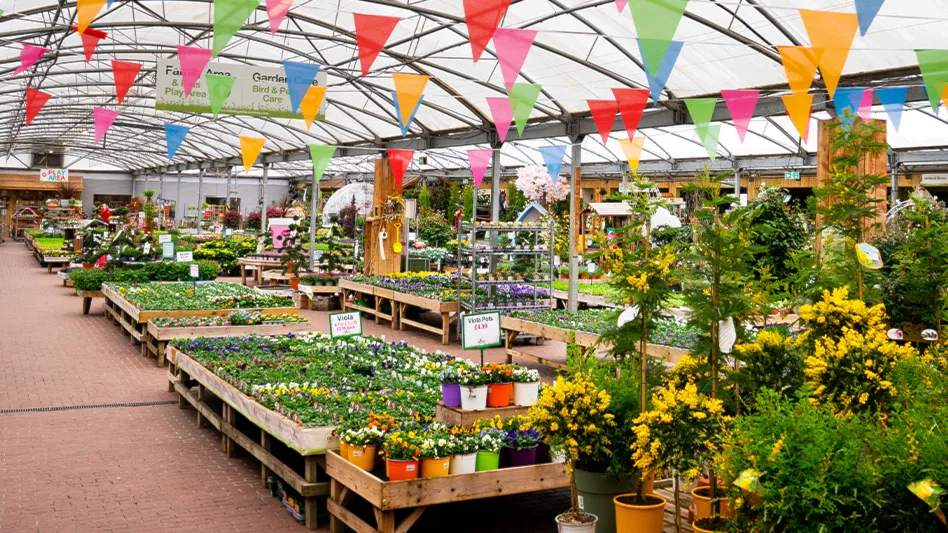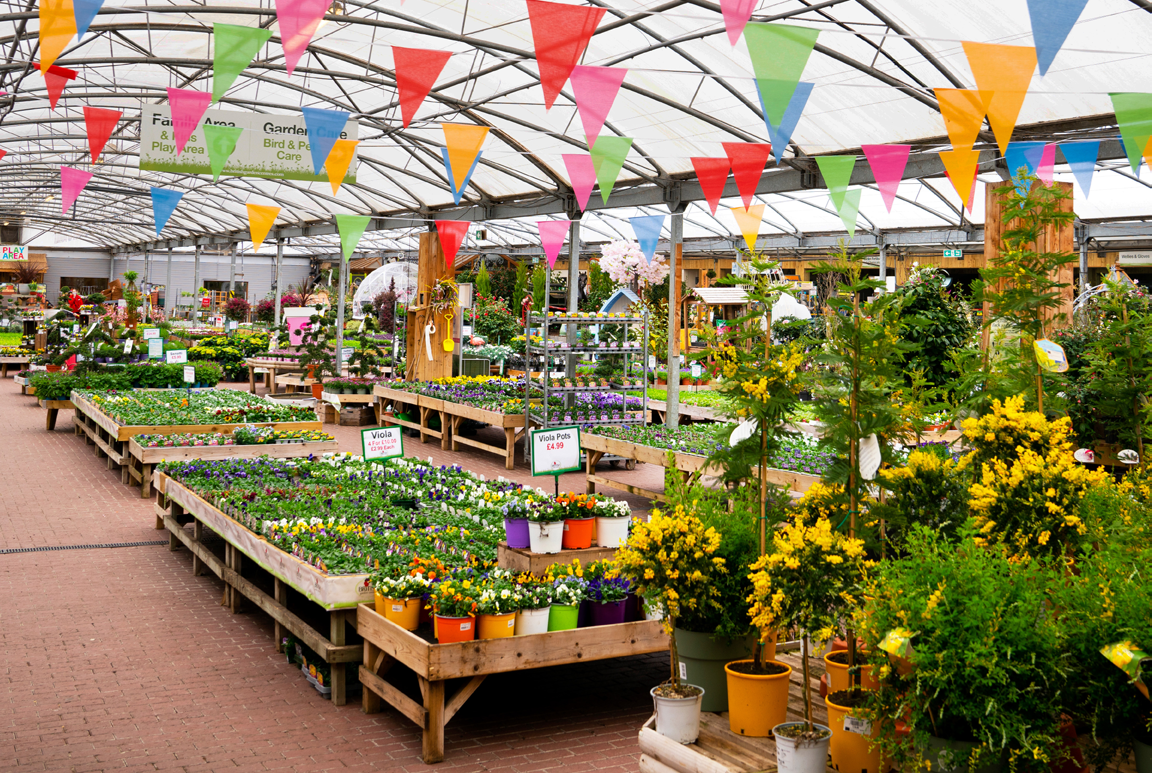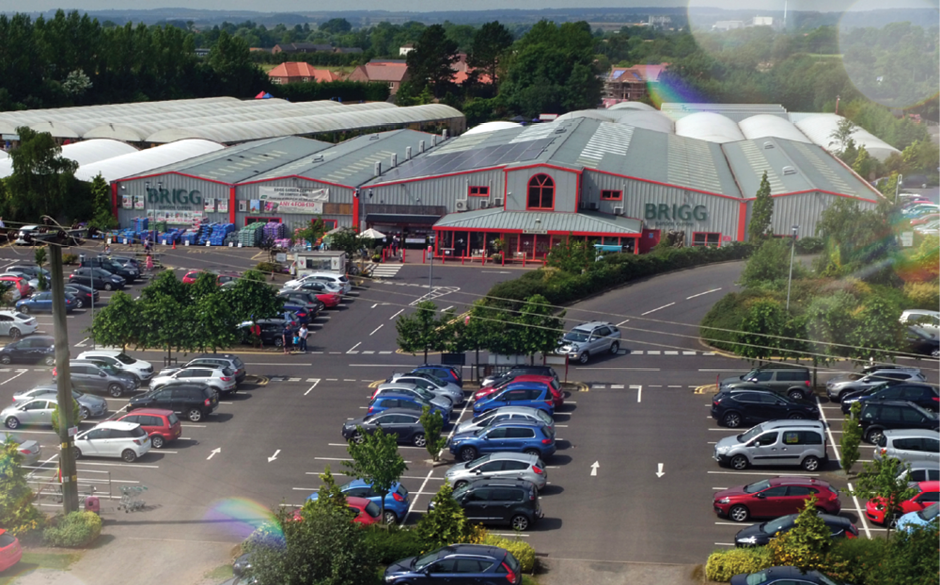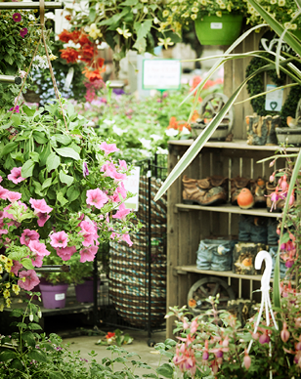

When Charles Stubbs took his first step into the green industry, he was simply selling homegrown plants at the end of the family driveway. That small entrepreneurial endeavor has led Charles to build the largest family-owned and fastest-growing garden center chain in the UK — British Garden Centres (BGC). Now with 60 locations across the country, it’s the third-largest group by turnover in the UK and second-biggest by number of centers.
This is the true story of how large oak trees grow from acorns. On his 58th birthday, we sat down with Charles Stubbs and his daughter Amy Stubbs to talk about the history, the present and the future of the British Garden Centre Group, and throw the spotlight on its largest garden center — Brigg.
Charles started the business decades ago, and by 1987, he and his brother Robert had opened the first British Garden Centres location, Woodthorpe Garden Centre. The family business flourished under the ownership of the two brothers. It steadily grew over the next 30 years, adding a new garden center every other year or so, including the crown jewel: Brigg. The business grew consistently using its founding principles of offering good value for money and knowledgeable staff.
As the business approached 15 centers, Charles said to himself, “That’s it!” With that number of centers, his view was that he could have visited every one of them every week and keep a lean management system, but then it all changed.
Charles explains that while working away at their East Durham Garden Centre, where he had just received planning permissions to build one of Europe’s biggest garden centers, he got some exciting news. Wyevale, the UK’s biggest garden center chain at the time, was going up for sale. The private equity house that had bought the business some years earlier was calling it a day.

Charles did some soul searching and considered that he could put all of the business’ money into Durham and make one large site, or he could go shopping for many new centers from Wyevale. No long decision-making process was needed; he went shopping.
Since 2018, the company has grown at a rate even faster than Charles and Robert could ever have imagined and British Garden Centres now has 60 centers around the country. Their ultimate ambition is to have a location in every county of the country and truly become a national chain of garden centers. And as the number of centers has grown so has the number of people in the team, with more than 2,700 colleagues working across the garden centers, restaurants, two nurseries, four distribution centers and more.
The family is delighted the next generation is working in the business, with Charles’ daughter Amy recently joining the team as group project and development manager.
“Amy joining the business is a dream come true,” Charles says. “Of course, it’s a proud moment when you see the next generation developing and succeeding in the business, but they must earn their stripes in exactly the same way as any other member of the team. It’s a fundamental pillar of our business strategy to develop talent from within the business wherever we can. We have a business philosophy that empowers our managers and their teams, so we need to be confident we have the best people.”
Whatever challenges the world may throw at them, they will remain true to their founding principles — great plants and products all year round, first-class service delivered by a wonderful team and all at affordable prices.

Lessons in layout
The changes Charles has made to the business have principally been driven by global pressures, not by the local garden center markets. The first of those changes have been a result of COVID.
When garden centers were able to re-open in the UK during the worldwide pandemic, UK legislation insisted that customers have a dedicated and structured way to walk around the garden centers. One of the key objectives was to give a 2-meter distance between customers.
With that in mind, BGC changed the entrance to Brigg and enabled customers to enter the store at the far end of the parking lot. This forced them to walk through the outdoor plant sales area into the garden center main building via the restaurant, flowing past the garden sundries shop and back to the tills.
Charles has since developed the idea so that today, customers still enter the garden center at the far end of the parking lot via a welcome lobby area which leads directly into the outdoor plants area. The welcome area is staffed every moment the site is open, ensuring that all customers get a warm welcome. It’s used as the customer information point but also doubles up as security to ensure that customers don’t walk out the entrance with items they haven’t paid for.
This change to the customer entrance has provided a dedicated route to ensure that customers are guided around the center in the direction the business requires. This, in effect, makes sure customers see all the products the business wants them to see as opposed to allowing the customers to walk wherever they want.
This allows maximum exposure of the product range to the customers. With the restaurant built at the back of the site, the newly developed path makes sure customers visit all parts of the site. “Customers used to miss out on half the center but now they are forced to shop all of it,” Charles says.

Responsible building
Another key change Charles would like to make to the physical structure would be improving insulation. The last 12 months have seen significant increases in heating costs for the retail buildings and Charles accepts, from an environmental standpoint, that the garden centers’ buildings should be of better insulation value to cut down on wasted heat and reduce the company’s carbon footprint.
Charles points out that you sometimes put buildings up as cheaply as you can at the beginning of a business venture without any consideration to ongoing maintenance and performance costs. As the business has developed, it has become more strategic in selecting the right building for the right purpose, not just considering the initial price of the building as the only criteria. He now considers the ongoing heating costs along with maintenance costs.
Restaurant expansion
Amy is keen to future-proof expansion. The parking lot at Brigg is now too small, she explains, and the restaurant’s kitchen and eating areas have been boxed in, which doesn’t allow for additional seating areas or kitchen expansions.
To combat this issue, the company is looking to move some staff parking. “We are looking to put a shuttle service in place for staff so they park off site at one location and we bus them in,” Amy says.
The restaurant now represents a third of the business’ income and can easily provide up to 50% of the profit in some months, with the largest gross margin contribution to the business. However, when the restaurant was first installed, its importance to the overall business was not yet fully appreciated. Now, it’s taking over some plant sales spaces.
“We have a significant power upgrade to be completed and then we will be turning over existing plant sales areas to the restaurant,” Amy says.
While plant sales will remain at the heart of the business, other entry points for more regular visits are key for the success of British Garden Centres. Evening out the seasonal swings in sales, as well as lulls in activity during the week or even the day, are vital for the business to grow and develop. Both Charles and Amy agree strongly on that. Food sales make up a third of the business in some years, and the leadership expects this will continue to grow.

Better building
Charles acknowledges three large capital items that in hindsight may not be the best use of funds. A mezzanine floor of some 4,000 square feet was installed approximately 10 years ago at Brigg in an attempt to increase the retail floor space. While Charles believes the use of a mezzanine for some retail environments is a good use of space, he says the additional space that was installed in his center was not designed correctly. If installing additional floor space, his view is that it needs to be very visible so that customers can see clearly defined entrance and exit stairways. It also requires a product offering that draws people upstairs, such as a restaurant. “It must become a go-to place within the center, otherwise customers just don’t bother shopping the upstairs space,” he explains,
The second lesson Charles has learned is to have more flexible space. With the covered space in the plant sales area, he would elect to go for a roof structure that can adapt to the weather. If it’s hot, the roof needs to open, and needs to shut when it’s cold. During British winters with low light levels, the roof needs to be made from a material that is more clear and open to the daylight and not a dark roof.
Charles would also like to change the fire walls to create a better use of space. He had two options: fixed solid walls with doors or curtain walling which drops from the ceiling if fire alarms are sounded. Charles elected for the cheaper solid wall option, and in doing so created a store with lots of various rooms and not one open space that he would have achieved with the use of fire curtains.
Lots of storage at the center is achieved using steel containers, but over the years this has become problematic. It reduces gross margins as stock gets easily damaged and it also becomes very time consuming and inefficient to look for product. It’s clear that Amy has spent far too many hours looking through various containers to find product for customers and a purpose-built storage facility would have been ideal, Amy says, adding that she has spent “too many hours in dark, wet containers.”
Beyond plants
Charles believes that growing the customer base for traditional garden center products like compost and plants is important, but it’s equally important to carry additional product that encourages customers to shop outside of the traditional garden planting season.
To that end, Charles has focused on Christmas as a key marketing tool for the business. He traditionally opens Christmas for the retail sales on the third weekend in September, a month earlier than most of his competitors. This, as he explains, brings customers into his center earlier and more often than his competitors.
“November was traditionally the second-worst profit month of the year and the business lost money,” he says of the days before he started promoting Christmas in September. “Now it’s the second-best month of the year to make money.”
Over the years he has built quite a reputation for Christmas arriving in the fall. It creates lots of customer reaction and social media interactions, most of it good with the occasional, “It’s too early” comments. The traditional opening weekend offers customer by invitation only to receive 20% off all of their Christmas purchases. Customers can obtain an invitation by completing an online form or by filling out a form in store. This builds his marketing database for the business.
This activity has grown over the years and now regularly sees the business take more than £100,000 per day during this promotional weekend period on Christmas products when its opened to the public. His overall view on Christmas remains the same — go big, go early and fill it with inspiration and ideas. Customers can go to any discount retailer to purchase Christmas products, but they want to be wowed. His approach is to fill them with excitement so they tell their friends and come back time and time again during the months of September, October, November and December.
Don’t sell the product off early in a sale, Charles says. Customers expect and accept that after Christmas Day, any remaining product will be in a sale but not before. Be true to your customers and provide them with value from the start, not discounts before Christmas. The BGC displays are very stock-heavy, so Charles and Amy are keen to offer customers the same choice at the start of the Christmas selling period as they do just before Christmas.
That requires effort, and lots of it, Amy says. “Displays have to have a wow factor, otherwise the stock just sits there,” she adds.

Future-proofing
Charles’ and Amy’s views of potential threats differ slightly. While Charles is of the opinion that margin loss due to internet sales will be a huge threat, Amy views the internet as a great opportunity.
“Everyone has a mobile phone and they use them walking around the store price checking,” Charles says. While Amy is of the opinion that, “It enables the business to reach new customers who haven’t been to the store before.”
They are, however, in agreement that climate change is a huge threat to the business whether it increases energy costs, extreme weather or the reduction and/or removal of peat-based products and chemical-based solutions for retail sales. Staff and customers will need to learn together with the changing climate, not just for the products they sell, but also for the plants to grow in new conditions.
Improvements on the horizon
As the business moves further away from a traditional garden center to more of a retail leisure destination, the right balance of experiences and activities will be key for the customer of the future. Whether it is crazy golf, 10-pin bowling or cooking classes, they are all on the radar of this expanding group headed up by the father-and-daughter team.
“We are constantly reviewing ideas and visiting competitors, learning from what they have done so that we can bring additional leisure experiences to our business,” Charles says.
In line with the desire to move the business into an expanding leisure retail experience hub, the duo thinks that the garden center will eventually have services such as travel agents, spas, nail bars, post offices, pharmacies and hairdressers.
In terms of product ranges, the business is likely to move into more leisure items like sports equipment and kitchen items. The business has already seen a huge growth in outdoor kitchen spaces, and Charles and Amy both believe this will extend indoors. Charles can see the day when they sell most items for the home and garden as well as leisure activities, not just gardening items.
Efficiency of the workforce to drive the business will be high on the list of future improvements as the company learns to do more with less. The labor market within the UK has almost zero unemployment. When Britain left the European Union, many continental workers went back to their native countries and the reduction of the labor market all across the UK has caused significant problems. Not only is trained horticultural staff needed, but the overall availability of employment for hospitality is of major concern, Amy says.
The business will need to become smarter when it comes to energy as well. Charles says he is considering the use of infrared heating instead of traditional heating methods, and introducing solar panels to reduce costs and make the business more efficient.
Pie-in-the-sky goals
Charles and Amy both agree on the three key areas needed for the business if money were no object — invest in the people (both staff and customers), invest in community facilities and add restaurant offerings.
Charles explains that he’d like to operate his own national horticultural training center so that the next generation of horticulture professionals are available to work in garden centers. “Without a trained team you have nothing,” he says.
Charles would also be keen to allow the center to become the heart of the community and have facilities for the use of school groups, youth organizations and the retired community, no matter if that’s for yoga groups or gardening clubs. Amy is quick to point out that the sooner they offer a wide range of leisure experiences and become a “full day out” visitor retail experience, the better.
Food and restaurants are so key to the business that a wider range of food offerings would be a great addition to the business, as well. BGC currently operates two restaurants— one for parents and children next to the children’s play barn and another has a more general offering.
But BGC is ready for a third restaurant style, Amy says. Not every customer wants to que up in a canteen-style line, and a higher-end, premium offering aimed at couples is a key capital investment for the business.
Social connections
Amy believes that social media will be “the most important” marketing tool the business has in years to come. She believes new platforms will be available that will become fully integrated with the business. “The use of social influencers is key to grow social media quickly,” she says.
She can see a day when customers use augmented reality to see the garden they want. That could include renting out headsets to customers who come into the garden center to show what furniture would look like in their garden. They could then share photos on social media, and friends and family would comment in real time before the customer makes a purchase.
Amy believes that social media will also allow them to introduce the staff to customers more easily. They will be able to have local personalities working at the centers who become known in the area and recognizable for the customers.

Tech impact
Information technology is enabling the business to better manage the stock flow to the customers. That capability is vital for the continued growth of the business, allowing BGC to manage its stock and its cash more efficiently.
Whether it’s having the right stock in store at the right time of year or using customer data to target promotions, a fully integrated approach helps the company understand what their customers buy and when.
Supply chain strategies
Currently operating three nurseries around the country, the business is about to embark on its biggest nursery growth yet with a new facility in the center of the country idea for distribution.
The death of the middleman is likely to be on the horizon, Charles and Amy explain. Increasingly buying direct and taking out double handling of any product will be key. They see a future where garden furniture and BBQs are delivered directly from their own distribution center by a team who assembles the product for the customers and takes all the waste packaging taken away so it can be recycled and sensible managed.
They see British growers receiving more business and not using foreign and continental plant importers as a key growth area. Seeking out and working with specific British growers for British plant stock will be important. This year they are launching a number of initiatives with specific growers for product such as hardy eucalyptus and ones with container gardening specialists.
Human resources
Where are the new garden center managers and plant area managers coming from? That’s a big question for the father-daughter team. The key to offering great customer service with knowledge is having trained and enthusiastic horticulturists. Garden centers big and small need to come together with the supply chain for the benefit of everyone to solve this issue, of that both Charles and Amy are certain.
As technology has developed, so has online training courses which is fine for the masses, but Charles believes in talking and showing. He is a person who spends hours a week travelling between his centers and to visit with his team. He is a person who spends time either on the phone or face to face, not “hiding behind a screen or email,” he says.
It’s those fundamentals that make him believe being in person with trainers and peer groups is key.

Family values
“I have never worked a day in my life,” Charles says of his career. “The business is a lifelong hobby.” And as long as he continues to enjoy it, he will continue to travel the country to meet members of his 2,500-member team, looking at developing centers and buying new ones, just not as often.
Amy, however, sees herself one day having the reins to the business, but not in the next five years. She is honest in saying that she has so much to learn and so many people to learn from before she is comfortable in heading up the combined business which turns over nearly half a billion dollars a year. She is in no way daunted by the opportunity to be the overall boss one day. What is daunting, she says, is just how much she must learn to be ready.
“I see myself getting more involved in the business and starting to influence things with my main interest being marketing and social media,” Amy says.
One thing is for sure though: She has a very supportive team who is keen to help. And in her father she has a mentor and a role model that is second to none. Charles is without exception the modern-day horticultural entrepreneur, someone who struggles with many things in the business world like IT and emails, but someone who has the fire and motivation to try and succeed with a team who fully support him, his daughter and the wider family business.

Explore the April 2023 Issue
Check out more from this issue and find you next story to read.
Latest from Garden Center
- Weekend Reading 5/17/24
- GardenComm 2024 Annual Conference registration is open
- Landmark Plastic celebrates 40 years
- Proven Winners introduces more than 100 new varieties for 2025
- Weekend Reading 5/10/24
- The Family Business, Part 2: Agreeing (and disagreeing) on capital investments
- Registration opens for Darwin Perennials Day
- Weekend Reading 5/3/24





